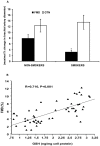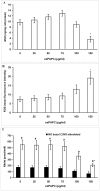Serum oxidative stress-induced repression of Nrf2 and GSH depletion: a mechanism potentially involved in endothelial dysfunction of young smokers
- PMID: 22272327
- PMCID: PMC3260271
- DOI: 10.1371/journal.pone.0030291
Serum oxidative stress-induced repression of Nrf2 and GSH depletion: a mechanism potentially involved in endothelial dysfunction of young smokers
Abstract
Background: Although oxidative stress plays a major role in endothelial dysfunction (ED), the role of glutathione (GSH), of nuclear erythroid-related factor 2 (Nrf2) and of related antioxidant genes (ARE) are yet unknown. In this study we combined an in vivo with an in vitro model to assess whether cigarette smoking affects flow-mediated vasodilation (FMD), GSH concentrations and the Nrf2/ARE pathway in human umbilical vein endothelial cells (HUVECs).
Methods and results: 52 healthy subjects (26 non-smokers and 26 heavy smokers) were enrolled in this study. In smokers we demonstrated increased oxidative stress, i.e., reduced concentrations of GSH and increased concentrations of oxidation products of the phospholipid 1-palmitoyl-2-arachidonyl-sn-glycero-3-phosphorylcholine (oxPAPC) in serum and in peripheral blood mononuclear cells (PBMC), used as in vivo surrogates of endothelial cells. Moreover we showed impairment of FMD in smokers and a positive correlation with the concentration of GSH in PBMC of all subjects. In HUVECs exposed to smokers' serum but not to non-smokers' serum we found that oxidative stress increased, whereas nitric oxide and GSH concentrations decreased; interestingly the expression of Nrf2, of heme oxygenase-1 (HO-1) and of glutamate-cysteine ligase catalytic (GCLC) subunit, the rate-limiting step of synthesis of GSH, was decreased. To test the hypothesis that the increased oxidative stress in smokers may have a causal role in the repression of Nrf2/ARE pathway, we exposed HUVECs to increasing concentrations of oxPAPC and found that at the highest concentration (similar to that found in smokers' serum) the expression of Nrf2/ARE pathway was reduced. The knockdown of Nrf2 was associated to a significant reduction of HO-1 and GCLC expression induced by oxPAPC in ECs.
Conclusions: In young smokers with ED a novel further consequence of increased oxidative stress is a repression of Nrf2/ARE pathway leading to GSH depletion.
Conflict of interest statement
Figures






Similar articles
-
Cigarette smoking blocks the protective expression of Nrf2/ARE pathway in peripheral mononuclear cells of young heavy smokers favouring inflammation.PLoS One. 2009 Dec 9;4(12):e8225. doi: 10.1371/journal.pone.0008225. PLoS One. 2009. PMID: 20011043 Free PMC article.
-
Sulodexide protects endothelial cells against 4-hydroxynonenal-induced oxidative stress and glutathione-dependent redox imbalance by modulation of sestrin2/nuclear factor erythroid 2-related factor 2 pathway.J Physiol Pharmacol. 2024 Aug;75(4). doi: 10.26402/jpp.2024.4.03. Epub 2024 Oct 10. J Physiol Pharmacol. 2024. PMID: 39415523
-
Willow bark extract increases antioxidant enzymes and reduces oxidative stress through activation of Nrf2 in vascular endothelial cells and Caenorhabditis elegans.Free Radic Biol Med. 2013 Dec;65:1506-1515. doi: 10.1016/j.freeradbiomed.2012.12.006. Epub 2012 Dec 28. Free Radic Biol Med. 2013. PMID: 23277146 Free PMC article.
-
A Systematic Review of the Various Effect of Arsenic on Glutathione Synthesis In Vitro and In Vivo.Biomed Res Int. 2020 Jul 28;2020:9414196. doi: 10.1155/2020/9414196. eCollection 2020. Biomed Res Int. 2020. PMID: 32802886 Free PMC article.
-
Redox status in mammalian cells and stem cells during culture in vitro: critical roles of Nrf2 and cystine transporter activity in the maintenance of redox balance.Redox Biol. 2014 Apr 18;2:786-94. doi: 10.1016/j.redox.2014.04.008. eCollection 2014. Redox Biol. 2014. PMID: 25009780 Free PMC article. Review.
Cited by
-
Vascular Inflammation and Oxidative Stress: Major Triggers for Cardiovascular Disease.Oxid Med Cell Longev. 2019 Jun 23;2019:7092151. doi: 10.1155/2019/7092151. eCollection 2019. Oxid Med Cell Longev. 2019. PMID: 31341533 Free PMC article. Review.
-
Preventive and therapeutic effects of MG132 by activating Nrf2-ARE signaling pathway on oxidative stress-induced cardiovascular and renal injury.Oxid Med Cell Longev. 2013;2013:306073. doi: 10.1155/2013/306073. Epub 2013 Mar 7. Oxid Med Cell Longev. 2013. PMID: 23533688 Free PMC article. Review.
-
Nrf2 expression is increased in peripheral blood mononuclear cells derived from mild-moderate ex-smoker COPD patients with persistent oxidative stress.Int J Chron Obstruct Pulmon Dis. 2016 Jul 28;11:1733-43. doi: 10.2147/COPD.S102218. eCollection 2016. Int J Chron Obstruct Pulmon Dis. 2016. PMID: 27555763 Free PMC article.
-
Lysophosphatidylcholine and carotid intima-media thickness in young smokers: a role for oxidized LDL-induced expression of PBMC lipoprotein-associated phospholipase A2?PLoS One. 2013 Dec 17;8(12):e83092. doi: 10.1371/journal.pone.0083092. eCollection 2013. PLoS One. 2013. PMID: 24358251 Free PMC article.
-
COPD as an endothelial disorder: endothelial injury linking lesions in the lungs and other organs? (2017 Grover Conference Series).Pulm Circ. 2018 Jan-Mar;8(1):2045894018758528. doi: 10.1177/2045894018758528. Pulm Circ. 2018. PMID: 29468936 Free PMC article.
References
-
- Benowitz N. Cigarette smoking and cardiovascular disease: pathophysiology and implications for treatment. Prog Cardiovasc Dis. 2003;46:91–111. - PubMed
-
- Yanbaeva DG, Dentener MA, Creutzberg EC, Wesseling G, Wouters EF. Systemic effects of smoking. Chest. 2007;131:1557–1566. - PubMed
-
- Zang LY, Stone K, Pryor WA. Detection of free radicals in aqueous extract of cigarette tar by electron spin resonance. Free Radic Biol Med. 1995;19:161–167. - PubMed
-
- Fruhwirth GO, Loidl A, Hermetter H. Oxidized phospholipids: from molecular properties to disease. Biochim et Biophys Acta. 2007;1772:718–736. - PubMed
Publication types
MeSH terms
Substances
LinkOut - more resources
Full Text Sources
Medical
Miscellaneous

